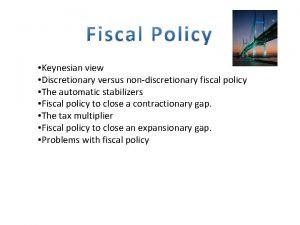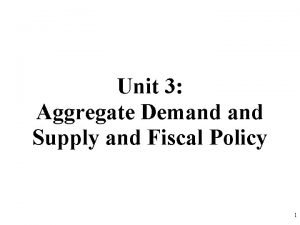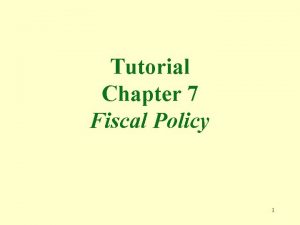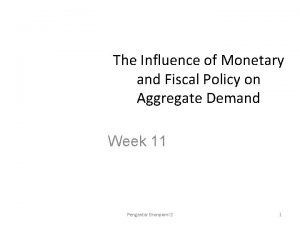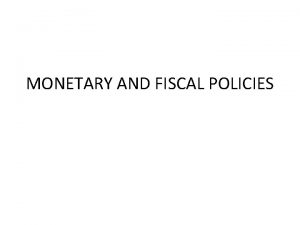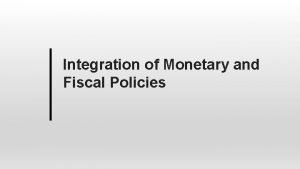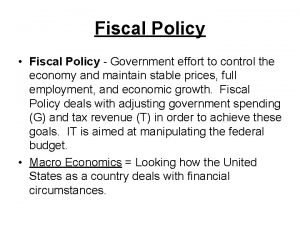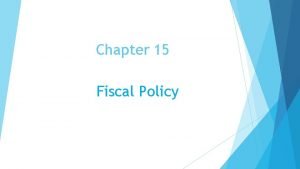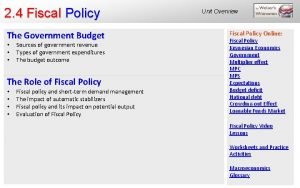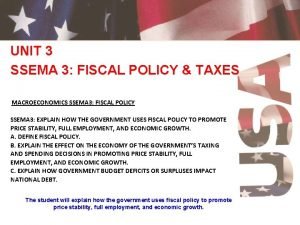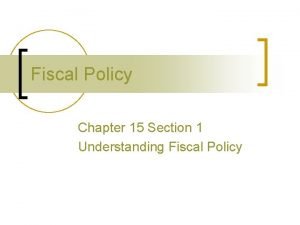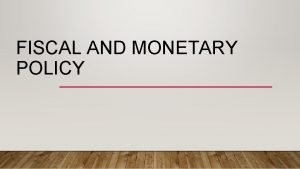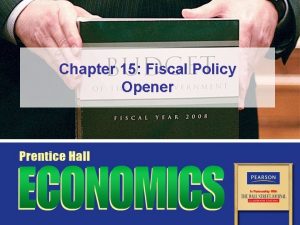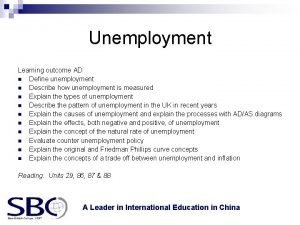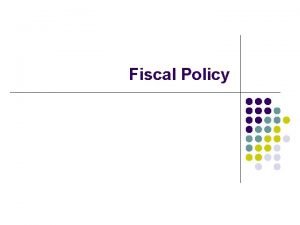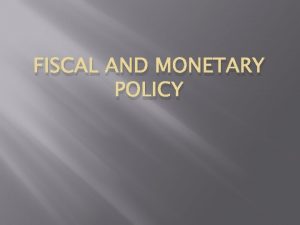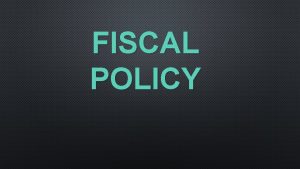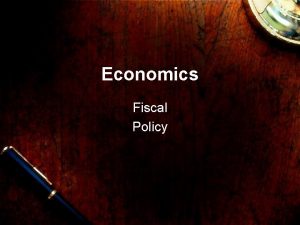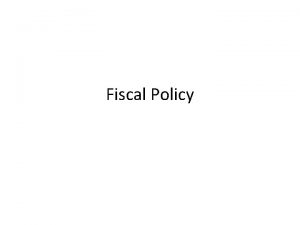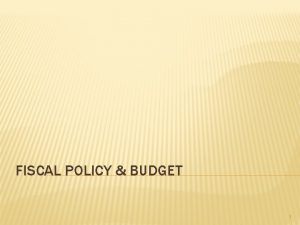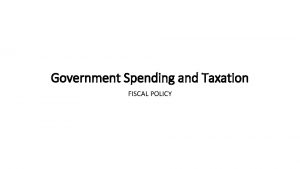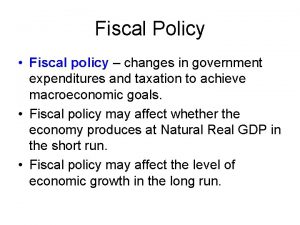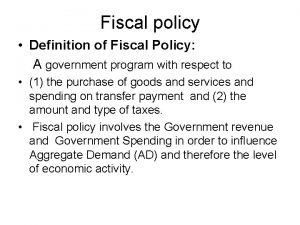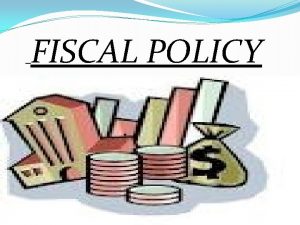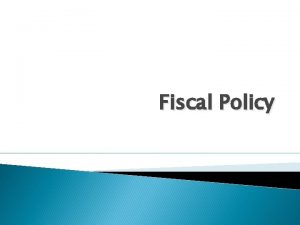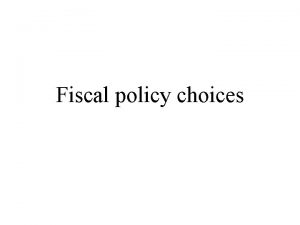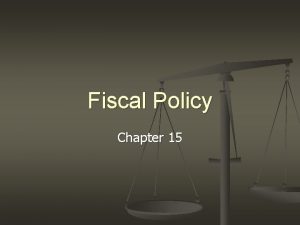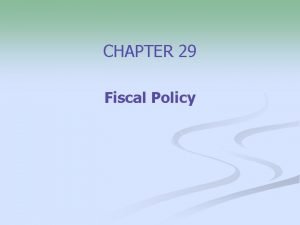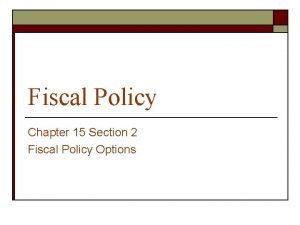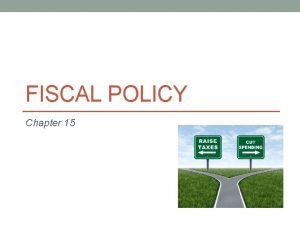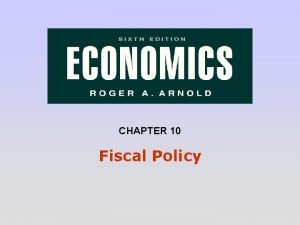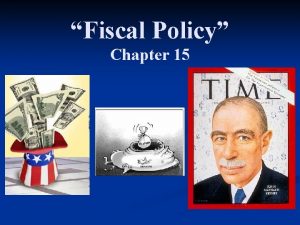The Government and Fiscal Policy 24 CHAPTER OUTLINE

































- Slides: 33

The Government and Fiscal Policy 24 CHAPTER OUTLINE Government in the Economy Government Purchases (G), Net Taxes (T), and Disposable Income (Yd) The Determination of Equilibrium Output (Income) Fiscal Policy at Work: Multiplier Effects The Government Spending Multiplier The Tax Multiplier The Balanced-Budget Multiplier PART V The Core of Macroeconomic Theory The Federal Budget © 2012 Pearson Education The Budget in 2009 Fiscal Policy Since 1993: The Clinton, Bush, and Obama Administrations The Federal Government Debt The Economy’s Influence on the Government Budget Automatic Stabilizers and Destabilizers Full-Employment Budget Looking Ahead Appendix A: Deriving the Fiscal Policy Multipliers Appendix B: The Case in Which Tax Revenues Depend on Income 1 of 42

PART V The Core of Macroeconomic Theory fiscal policy The government’s spending and taxing policies. monetary policy The behavior of the Central Bank concerning the nation’s money supply. © 2012 Pearson Education 2 of 42

Government in the Economy discretionary fiscal policy Changes in taxes or spending that are the result of deliberate changes in government policy. Government Purchases (G), Net Taxes (T), and Disposable Income (Yd) PART V The Core of Macroeconomic Theory net taxes (T) Taxes paid by firms and households to the government minus transfer payments made to households by the government. disposable, or after-tax, income (Yd) Total income minus net taxes: Y − T. © 2012 Pearson Education disposable income ≡ total income − net taxes Yd ≡ Y − T 3 of 42

Government in the Economy Government Purchases (G), Net Taxes (T), and Disposable Income (Yd) PART V The Core of Macroeconomic Theory FIGURE 24. 1 Adding Net Taxes (T) and Government Purchases (G) to the Circular Flow of Income © 2012 Pearson Education 4 of 42

Government in the Economy Government Purchases (G), Net Taxes (T), and Disposable Income (Yd) The disposable income (Yd) of households must end up as either consumption (C) or saving (S). Thus, PART V The Core of Macroeconomic Theory Because disposable income is aggregate income (Y) minus net taxes (T), we can write another identity: By adding T to both sides: Planned aggregate expenditure (AE) is the sum of consumption spending by households (C), planned investment by business firms (I), and government purchases of goods and services (G). © 2012 Pearson Education 5 of 42

Government in the Economy Government Purchases (G), Net Taxes (T), and Disposable Income (Yd) budget deficit The difference between what a government spends and what it collects in taxes in a given period: G − T. PART V The Core of Macroeconomic Theory budget deficit ≡ G − T © 2012 Pearson Education 6 of 42

Government in the Economy Government Purchases (G), Net Taxes (T), and Disposable Income (Yd) Adding Taxes to the Consumption Function To modify our aggregate consumption function to incorporate disposable income instead of before-tax income, instead of C = a + b. Y, we write PART V The Core of Macroeconomic Theory C = a + b. Yd © 2012 Pearson Education or C = a + b(Y − T) Our consumption function now has consumption depending on disposable income instead of before-tax income. 7 of 42

Government in the Economy Government Purchases (G), Net Taxes (T), and Disposable Income (Yd) Planned Investment PART V The Core of Macroeconomic Theory The government can affect investment behavior through its tax treatment of depreciation and other tax policies. © 2012 Pearson Education 8 of 42

Government in the Economy The Determination of Equilibrium Output (Income) Y=C+I+G TABLE 24. 1 Finding Equilibrium for I = 100, G = 100, and T = 100 (1) (2) (3) (4) PART V The Core of Macroeconomic Theory Output Net Disposable Consumption (Income) Taxes Income Spending Y T Yd ≡Y - T C = 100 +. 75 Yd (5) (6) (7) (8) (9) (10) Planned Unplanned Saving Investment Government Aggregate Inventory Adjustment S Spending Purchases Expenditure Change to Disequi. Yd – C I G C + I + G Y - (C + I + G) librium 300 100 250 - 50 100 450 - 150 Output ↑ 500 100 400 0 100 600 - 100 Output ↑ 700 100 600 550 50 100 750 - 50 Output ↑ 900 100 800 700 100 100 900 0 1, 100 1, 000 850 100 1, 050 + 50 Output ↓ 1, 300 1, 200 1, 000 200 100 1, 200 + 100 Output ↓ 1, 500 1, 400 1, 150 250 100 1, 350 + 150 Output ↓ © 2012 Pearson Education Equilibrium 9 of 42

Government in the Economy The Determination of Equilibrium Output (Income) FIGURE 24. 2 Finding Equilibrium Output/Income Graphically PART V The Core of Macroeconomic Theory Because G and I are both fixed at 100, the aggregate expenditure function is the new consumption function displaced upward by I + G = 200. Equilibrium occurs at Y = C + I + G = 900. © 2012 Pearson Education 10 of 42

Government in the Economy The Determination of Equilibrium Output (Income) The Saving/Investment Approach to Equilibrium saving/investment approach to equilibrium: PART V The Core of Macroeconomic Theory S+T=I+G © 2012 Pearson Education To derive this, we know that in equilibrium, aggregate output (income) (Y) equals planned aggregate expenditure (AE). By definition, AE equals C + I + G, and by definition, Y equals C + S + T. Therefore, at equilibrium: C+S+T=C+I+G Subtracting C from both sides leaves: S+T=I+G 11 of 42

Fiscal Policy at Work: Multiplier Effects At this point, we are assuming that the government controls G and T. In this section, we will review three multipliers: Government spending multiplier Tax multiplier PART V The Core of Macroeconomic Theory Balanced-budget multiplier © 2012 Pearson Education 12 of 42

Fiscal Policy at Work: Multiplier Effects The Government Spending Multiplier PART V The Core of Macroeconomic Theory government spending multiplier The ratio of the change in the equilibrium level of output to a change in government spending. © 2012 Pearson Education 13 of 42

Fiscal Policy at Work: Multiplier Effects The Government Spending Multiplier TABLE 24. 2 Finding Equilibrium after a Government Spending Increase of 50 (G Has Increased from 100 in Table 9. 1 to 150 Here) (1) (2) (3) (4) PART V The Core of Macroeconomic Theory Output Net Disposable Consumption (Income) Taxes Income Spending Y T Yd ≡Y - T C = 100 +. 75 Yd (5) (6) (7) (8) (9) (10) Unplanned Planned Inventory Saving Investment Government Aggregate Adjustment Change S Spending Purchases Expenditure Y - (C + I + to Yd – C I G C+I+G G) Disequilibrium 300 100 250 - 50 100 150 500 - 200 Output ↑ 500 100 400 0 100 150 650 - 150 Output ↑ 700 100 600 550 50 100 150 800 - 100 Output ↑ 900 100 800 700 100 150 950 - 50 Output ↑ 1, 100 1, 000 850 100 150 1, 100 0 1, 300 1, 200 1, 000 200 150 1, 250 + 50 © 2012 Pearson Education Equilibrium Output ↓ 14 of 42

Fiscal Policy at Work: Multiplier Effects The Government Spending Multiplier FIGURE 24. 3 The Government Spending Multiplier PART V The Core of Macroeconomic Theory Increasing government spending by 50 shifts the AE function up by 50. As Y rises in response, additional consumption is generated. Overall, the equilibrium level of Y increases by 200, from 900 to 1, 100. © 2012 Pearson Education 15 of 42

Fiscal Policy at Work: Multiplier Effects The Tax Multiplier tax multiplier The ratio of change in the equilibrium level of output to a change in taxes. PART V The Core of Macroeconomic Theory Because the initial change in aggregate expenditure caused by a tax change of ∆T is (−∆T × MPC), we can solve for the tax multiplier by substitution: Because a tax cut will cause an increase in consumption expenditures and output and a tax increase will cause a reduction in consumption expenditures and output, the tax multiplier is a negative multiplier: © 2012 Pearson Education 16 of 42

Fiscal Policy at Work: Multiplier Effects The Balanced-Budget Multiplier PART V The Core of Macroeconomic Theory balanced-budget multiplier The ratio of change in the equilibrium level of output to a change in government spending where the change in government spending is balanced by a change in taxes so as not to create any deficit. The balanced-budget multiplier is equal to 1: The change in Y resulting from the change in G and the equal change in T are exactly the same size as the initial change in G or T. © 2012 Pearson Education 17 of 42

Fiscal Policy at Work: Multiplier Effects The Balanced-Budget Multiplier TABLE 24. 3 Finding Equilibrium after a Balanced-Budget Increase in G and T of 200 Each (Both G and T Have Increased from 100 in Table 9. 1 to 300 Here) (1) (2) (3) (4) PART V The Core of Macroeconomic Theory Output Net Disposable Consumption (Income) Taxes Income Spending Y T Yd ≡Y - T C = 100 +. 75 Yd (5) (6) (7) (8) (9) Planned Unplanned Investment Government Aggregate Inventory Adjustment Spending Purchases Expenditure Change to I G C + I + G Y - (C + I + G) Disequilibrium 500 300 250 100 300 650 - 150 Output ↑ 700 300 400 100 300 800 - 100 Output ↑ 900 300 600 550 100 300 950 - 50 Output ↑ 1, 100 300 800 700 100 300 1, 100 0 1, 300 1, 000 850 100 300 1, 250 + 50 Output ↓ 1, 500 300 1, 200 1, 000 100 300 1, 400 + 100 Output ↓ © 2012 Pearson Education Equilibrium 18 of 42

Fiscal Policy at Work: Multiplier Effects The Balanced-Budget Multiplier TABLE 24. 4 Summary of Fiscal Policy Multipliers PART V The Core of Macroeconomic Theory Policy Stimulus Government spending multiplier Increase or decrease in the level of government purchases: ∆G Tax multiplier Increase or decrease in the level of net taxes: ∆T Balanced-budget multiplier Simultaneous balanced-budget increase or decrease in the level of government purchases and net taxes: ∆G = ∆T © 2012 Pearson Education Multiplier Final Impact on Equilibrium Y 1 19 of 42

Fiscal Policy at Work: Multiplier Effects The Balanced-Budget Multiplier A Warning Although we have added government, the story told about the multiplier is still incomplete and oversimplified. PART V The Core of Macroeconomic Theory We have been treating net taxes (T) as a lump-sum, fixed amount, whereas in practice, taxes depend on income. © 2012 Pearson Education Appendix B to this chapter shows that the size of the multiplier is reduced when we make the more realistic assumption that taxes depend on income. We continue to add more realism and difficulty to our analysis in the chapters that follow. 20 of 42

The Federal Budget federal budget The budget of the federal government. The “budget” is really three different budgets: It is a political document that dispenses favors to certain groups or regions and places burdens on others. PART V The Core of Macroeconomic Theory It is a reflection of goals the government wants to achieve. The budget may be an embodiment of some beliefs about how (if at all) the government should manage the macroeconomy. © 2012 Pearson Education 21 of 42

The Federal Budget The Budget in 2009 PART V The Core of Macroeconomic Theory federal surplus (+) or deficit (−) Federal government receipts minus expenditures. © 2012 Pearson Education 22 of 42

The Federal Budget The Federal Government Debt federal debt The total amount owed by the federal government. PART V The Core of Macroeconomic Theory privately held federal debt The privately held (non-governmentowned) debt of the U. S. government. © 2012 Pearson Education 23 of 42

The Economy’s Influence on the Government Budget Automatic Stabilizers and Destabilizers automatic stabilizers Revenue and expenditure items in the federal budget that automatically change with the state of the economy in such a way as to stabilize GDP. PART V The Core of Macroeconomic Theory automatic destabilizer Revenue and expenditure items in the federal budget that automatically change with the state of the economy in such a way as to destabilize GDP. fiscal drag The negative effect on the economy that occurs when average tax rates increase because taxpayers have moved into higher income brackets during an expansion. © 2012 Pearson Education 24 of 42

The Economy’s Influence on the Government Budget Full-Employment Budget full-employment budget What the federal budget would be if the economy were producing at the full-employment level of output. PART V The Core of Macroeconomic Theory structural deficit The deficit that remains at full employment. cyclical deficit The deficit that occurs because of a downturn in the business cycle. © 2012 Pearson Education 25 of 42

REVIEW TERMS AND CONCEPTS automatic destabilizers privately held federal debt automatic stabilizers structural deficit balanced-budget multiplier tax multiplier budget deficit 1. Disposable income Yd ≡ Y − T cyclical deficit 2. AE ≡ C + I + G discretionary fiscal policy 3. Government budget deficit ≡ G − T disposable, or after-tax, income (Yd) 4. Equilibrium in an economy with a government: Y = C + I + G federal budget PART V The Core of Macroeconomic Theory federal debt federal surplus (+) or deficit (−) fiscal drag fiscal policy full-employment budget government spending multiplier monetary policy net taxes (T) © 2012 Pearson Education 5. Saving/investment approach to equilibrium in an economy with a government: S + T = I + G 6. Government spending multiplier ≡ 7. Tax multiplier ≡ 8. Balanced-budget multiplier ≡ 1 26 of 42

CHAPTER 24 APPENDIX A Deriving the Fiscal Policy Multipliers The Government Spending and Tax Multipliers We can derive the multiplier algebraically using our hypothetical consumption function: The equilibrium condition is PART V The Core of Macroeconomic Theory By substituting for C, we get This equation can be rearranged to yield Now solve for Y by dividing through by (1 − b): © 2012 Pearson Education 27 of 42

CHAPTER 24 APPENDIX A Deriving the Fiscal Policy Multipliers The Balanced-Budget Multiplier It is easy to show formally that the balanced-budget multiplier = 1. PART V The Core of Macroeconomic Theory increase in spending: − decrease in spending: = net increase in spending In a balanced-budget increase, G = T; so we can substitute: © 2012 Pearson Education net initial increase in spending: G − G (MPC) = G (1 − MPC) 28 of 42

CHAPTER 24 APPENDIX A Deriving the Fiscal Policy Multipliers The Balanced-Budget Multiplier Because MPS = (1 − MPC), the net initial increase in spending is: G (MPS) PART V The Core of Macroeconomic Theory We can now apply the expenditure multiplier increase in spending: to this net initial Thus, the final total increase in the equilibrium level of Y is just equal to the initial balanced increase in G and T. © 2012 Pearson Education 29 of 42

CHAPTER 24 APPENDIX B The Case in Which Tax Revenues Depend on Income FIGURE 24 B. 1 The Tax Function PART V The Core of Macroeconomic Theory This graph shows net taxes (taxes minus transfer payments) as a function of aggregate income. © 2012 Pearson Education 30 of 42

CHAPTER 24 APPENDIX B PART V The Core of Macroeconomic Theory The Case in Which Tax Revenues Depend on Income FIGURE 24 B. 2 Different Tax Systems When taxes are strictly lump-sum (T = 100) and do not depend on income, the aggregate expenditure function is steeper than when taxes depend on income. © 2012 Pearson Education 31 of 42

CHAPTER 24 APPENDIX B The Case in Which Tax Revenues Depend on Incomes The Government Spending and Tax Multipliers Algebraically PART V The Core of Macroeconomic Theory Through substitution we get Solving for Y: © 2012 Pearson Education 32 of 42

CHAPTER 24 APPENDIX B The Case in Which Tax Revenues Depend on Incomes The Government Spending and Tax Multipliers Algebraically PART V The Core of Macroeconomic Theory This means that a $1 increase in G or I (holding a and T 0 constant) will increase the equilibrium level of Y by Holding a, I, and G constant, a fixed or lump-sum tax cut (a cut in T 0) will increase the equilibrium level of income by © 2012 Pearson Education 33 of 42
 Expansionary fiscal policy graph
Expansionary fiscal policy graph Unit 3 aggregate demand aggregate supply and fiscal policy
Unit 3 aggregate demand aggregate supply and fiscal policy Unit 3 aggregate demand aggregate supply and fiscal policy
Unit 3 aggregate demand aggregate supply and fiscal policy Expansionary gap
Expansionary gap Unit 3 aggregate demand aggregate supply and fiscal policy
Unit 3 aggregate demand aggregate supply and fiscal policy Demand pull inflation
Demand pull inflation Example fiscal policy
Example fiscal policy Government expenditure multiplier formula
Government expenditure multiplier formula Components of fiscal policy
Components of fiscal policy Crowding out effect of fiscal policy
Crowding out effect of fiscal policy Instruments of fiscal policy
Instruments of fiscal policy Fiscal policy
Fiscal policy Fiscal policy ib definition
Fiscal policy ib definition Fiscal demand side policy
Fiscal demand side policy Fiscal policy to control inflation
Fiscal policy to control inflation Types of fiscal policy
Types of fiscal policy Instruments of fiscal policy
Instruments of fiscal policy Crowding out definition ap macro
Crowding out definition ap macro Demand side fiscal policy definition
Demand side fiscal policy definition Contractory monetary policy
Contractory monetary policy Crowding out effect of fiscal policy
Crowding out effect of fiscal policy Example of expansionary fiscal policy
Example of expansionary fiscal policy Fiscal policy
Fiscal policy Goals of fiscal policy
Goals of fiscal policy Fiscal vs monetary policy
Fiscal vs monetary policy Goals of fiscal policy
Goals of fiscal policy Fiscal policy
Fiscal policy Unemployment
Unemployment Fiscal policy
Fiscal policy Features of fiscal policy ppt
Features of fiscal policy ppt Fiscal policy definition
Fiscal policy definition What is fiscal deficit
What is fiscal deficit Sandwich quotation
Sandwich quotation Gsa office of governmentwide policy
Gsa office of governmentwide policy



